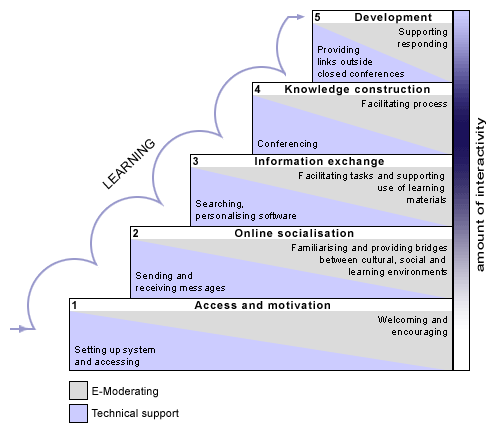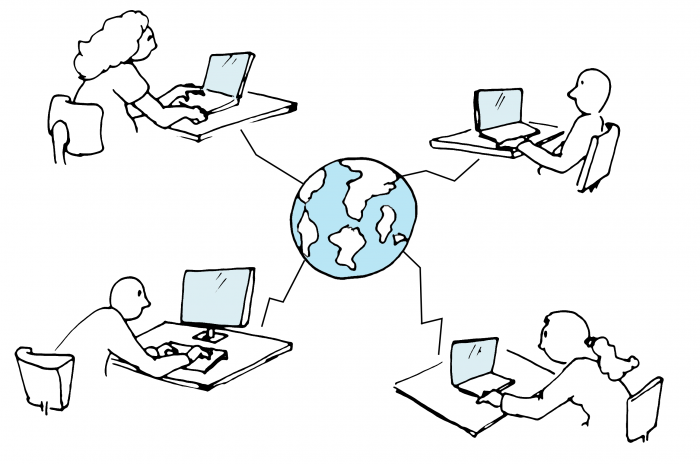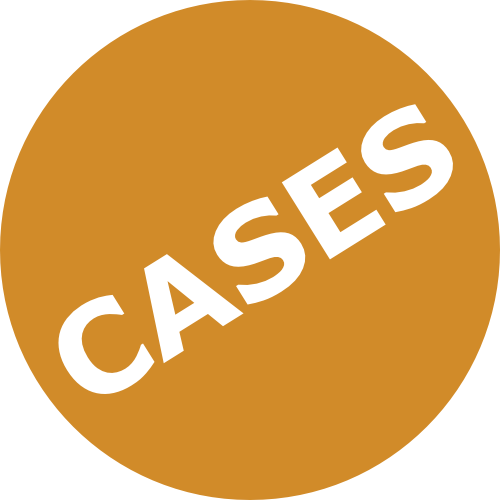Teacher: Department of Anthropology
Working with online communication and learning was new to both teachers and students at the Department of Anthropology therefore Gilly Salmon’s five-step-model was introduced and offered inspiration in the development of the online environment. Five assignments for reflection were constructed according to the five-step-model and identified as e-tivities. E-tivities are according to Salmon tasks that enables an active and participative online learning environment. E-tivities are beneficial because they deploy useful, well-rehearsed principles for online learning (www.gillysalmon.com/e-tivities). In this case the e-tivities were identified as:

- Your project, a description of the overall research question for the project
- Your field, a reflection and description on the basis of 3 – 4 weeks of fieldwork upon their field
- Your interlocutors, reflections on conversation partners and how they assist in answering the concrete research question
- Your field notes, which should assist the students in getting better field notes and make the empirical material operational for the master thesis
- Concepts, themes and contextualization, a focus on the analytical perspectives in the ethnographical material
The complexity of the e-tivities follows Salmons model and becomes more and more taxonomical challenging.
Absalon is the learning management system at the University of Copenhagen and was thus chosen as the preferred platform. Usually Absalon has been used for distributing learning content at campus so this time we had to rethink the course structure in Absalon. The e-tivities were organised as assignments with deadlines according to the semester plan and content pages covered the descriptions and explanations with text and pictures. Furthermore the students were divided into groups where they could communicate and share content in smaller environments that hopefully would make them more safe and able to know each other. As a default the groups contained two discussion forums – one for giving peer feedback on assignments and one for having social academic discussions at a personal as well as academic level.
An extra step was added to Salmons five-step-model which was a physical meeting where the students became acquainted with each other. The physical meeting was identified as a step 0 to the five-step-model and it was also here the students were divided into groups giving their geographical positions before going abroad.
Read more in the article: https://tidsskrift.dk/lom/article/view/24180?acceptCookies=1
What was your motivation?
The physical absence complicates the closeness to the department and the consequences have so far been that the antropology students experience loneliness as well as less academic focus during their fieldwork. It has also been difficult for some students to get back to the academic world and continue with their studies and master thesis which has prolonged their completion period.
How did you get started?
 The department realised that they had to come up with a solution where the students would feel obliged to an academic focus as well as being able to communicate with other students and academic staff during fieldwork. The purpose of designing an online environment was to establish both a social and academic learning environment.
The department realised that they had to come up with a solution where the students would feel obliged to an academic focus as well as being able to communicate with other students and academic staff during fieldwork. The purpose of designing an online environment was to establish both a social and academic learning environment.
How did it go?
It went very well and the students were very pleased. A few things in the Absalon set-up were adjusted in the coming semesters and it was also decided to make it mandatory for all students to take part in the fieldwork groups and the online environment because it was such a success.
What was the outcome for you - and the students?
The teachers involved from the Department of Anthropology were now able to support student learning during fieldwork in another way and the start-up meeting (step 0) identified the different roles before going on fieldwork.
Based on the evaluations the students are now safer and they share information and ask questions online at a very deep level both personal and academic.
The five assignments helped the students structure their research and the fixed deadlines kept the students motivated and on track. They learned from both giving and receiving feedback and the collaborative way of working made it possible to reflect upon own fieldwork experiences as well as being inspired by other student’s work.
How much time did you spend on it?
In the development stage extra hours were spend on meetings, investigation and working towards the most suitable solution.
Even more
This case describes how the Department of Anthropology has used Absalon as an online environment for communication while the students are away on fieldwork. The example can be transferred to other educations where students are away from the University either on fieldwork, internship or project work. Overall it is recommended that the online environment includes smaller groups where teacher and students can communicate at a more individual level, that students are obliged to hand-in a number of assignments during the semester and that there are some kind of peer feedback involved to keep the online environment alive and active.



 The department realised that they had to come up with a solution where the students would feel obliged to an academic focus as well as being able to communicate with other students and academic staff during fieldwork. The purpose of designing an online environment was to establish both a social and academic learning environment.
The department realised that they had to come up with a solution where the students would feel obliged to an academic focus as well as being able to communicate with other students and academic staff during fieldwork. The purpose of designing an online environment was to establish both a social and academic learning environment.